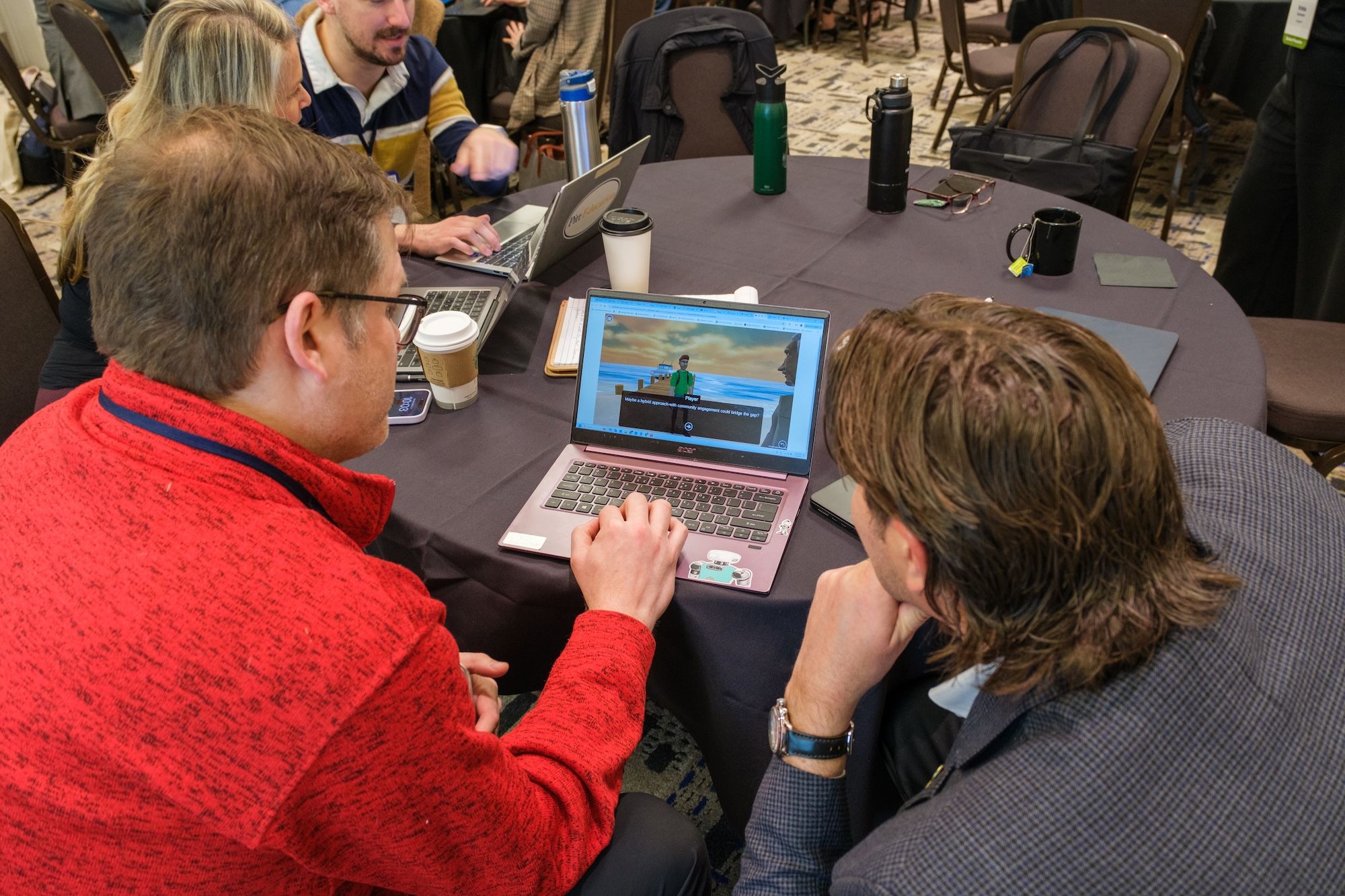Author: Anthony Baker
Key Ideas
- Storytelling has been shown to support students in engaging deeply with learning.
- The EngageAI Institute is exploring the intersection of generative AI (GenAI) and storytelling through a new tool called SceneCraft.
- At the League of Innovative School Spring Convening, 27 League of Innovative Schools members joined the EngageAI Institute to explore classroom applications of this novel technology.
At this year’s League of Innovative Schools meeting in Pittsburgh, Digital Promise invited educators and district leaders into an exciting and emerging space in education: the intersection of GenAI, storytelling, and instructional practice. The session wasn’t just about showcasing a new technology — it was about reimagining how we engage learners through story-rich, inquiry-driven experiences.
Why Stories?
We kicked things off with a simple but powerful question: What does it look like to craft learning narratives with generative AI?
Stories have long been central to how humans learn. From fables to case studies, narratives help us understand complex ideas, model social roles, and develop critical thinking. For decades, research in narrative-centered learning has shown how story-driven games can enhance STEM learning outcomes. Yet, until recently, creating custom, classroom-ready stories has been expensive, time-consuming, and often inaccessible for teachers.
The EngageAI Institute, a National Science Foundation-funded research effort, is exploring how generative AI can unlock new possibilities for story-based learning. Instead of simply using AI to automate lesson planning or grading, we’re interested in how it can empower educators and students to create and build rich characters, scenes, plots, and interactive experiences that align with instructional goals.
Introducing SceneCraft

The focus of our session was SceneCraft, a prototype tool developed by researchers at North Carolina State University. SceneCraft transforms user prompts into interactive 3D story experiences, using a large language model to generate scripts, dialogue, and scenes that are rendered in Unity and playable through a web browser.
What makes SceneCraft exciting isn’t just the technology; rather, it’s the potential for educators to design, build, and rapidly iterate instructional stories themselves. SceneCraft is still an early-stage prototype, and our goal was to explore how it might become a true learning tool as it continues to develop.
Hands-On Exploration
After a demo, convening participants rolled up their sleeves to explore SceneCraft. Small groups oriented themselves to the tool, brainstormed instructional uses, and used a shared template to design prototype stories that connect directly to pedagogy and curriculum.
The ideas that emerged were imaginative and grounded in real classroom needs. Some groups imagined story-driven science investigations, where students had to analyze data to solve a fictional environmental crisis. Others envisioned social studies simulations where students role-played historical figures in branching narratives. It was a testament to the creativity and practical wisdom of the League community. We regrouped to share story ideas and surface themes, discovering a common thread: engagement through agency. Teachers saw in SceneCraft a way to spark curiosity, foster collaboration, and invite students into meaningful problem-solving.
Four Bold Ideas for AI in Schools
In part two of the session, we zoomed out to look at the bigger picture: How should we bring research-based GenAI into practice? Together, we explored four key levers for impact and brainstormed “bold ideas” for each:
- Access: How do we ensure tools like SceneCraft reach schools equitably?
- Instruction: How do we support educators in integrating GenAI tools in ways that align with their values and pedagogy?
- Learning: How do we design experiences that center student agency and creativity?
- Safety: How do we keep ethical use, privacy, and student well-being at the forefront?
The ideas were thoughtful and forward-looking, ranging from regional collaboratives to co-developed open-source teacher guides to student AI use.
What’s Next?
SceneCraft is still in development, with testing planned in smaller settings this summer and a larger rollout planned in fall 2025.
SceneCraft isn’t just a tool, it’s an invitation. We’re not selling software; we’re co-designing a new kind of learning experience — one where GenAI might become a tool for inquiry, helping to bring stories to life, and where teachers are designers of deeply engaging instruction.
The League of Innovative Schools meeting is always a space for bold thinking, and this year was no exception. What made the EngageAI session so special was the spirit of curiosity and collaboration in the room; educators didn’t just ask “What can this technology do?” They asked, “What do we want learning to become?” That’s the question that will drive SceneCraft forward.
Educators who want to stay involved can continue story-building with us, provide feedback on exemplars, or help shape future iterations of the tool.

